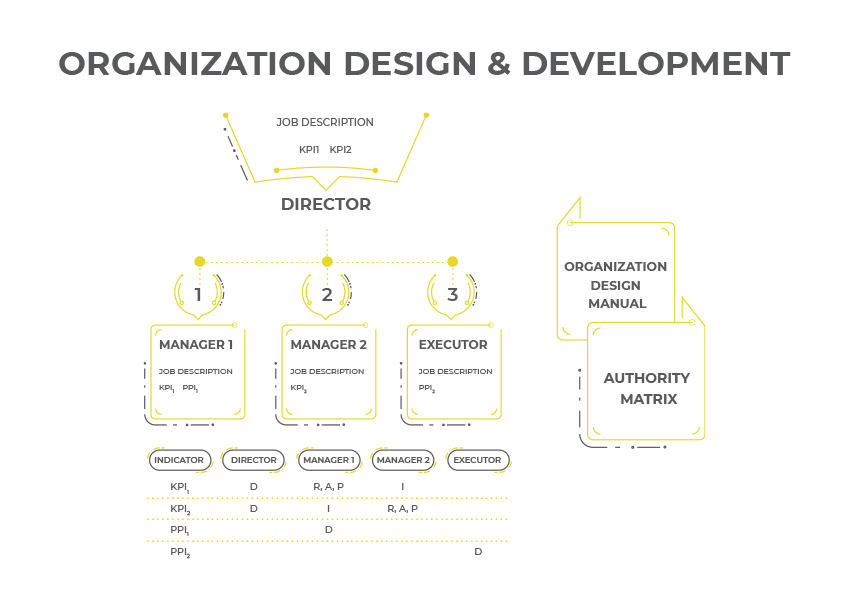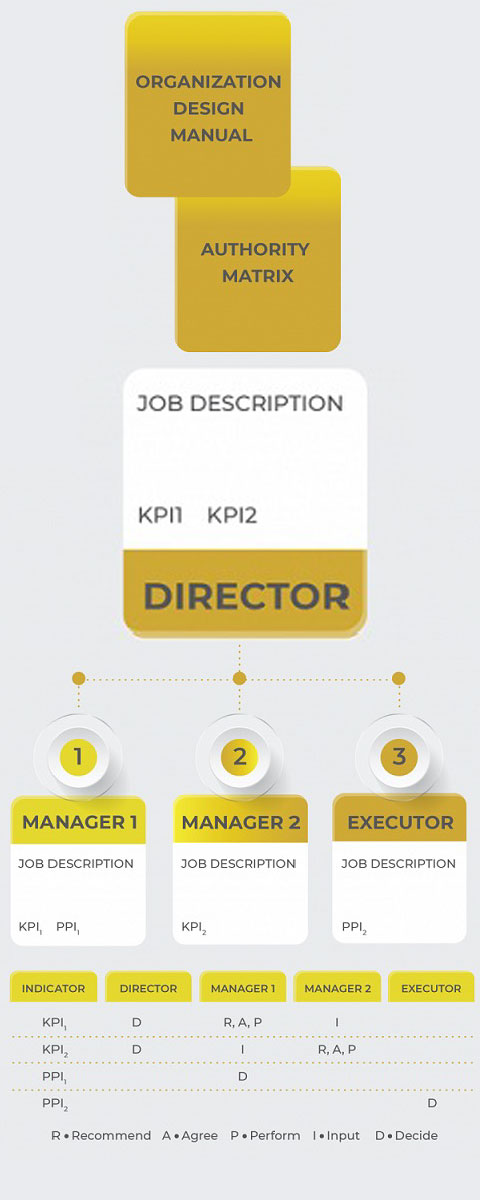
11 Oct Organization Design & Development
Organization Design & Development (OD & D) is frequently associated with the drawing of boxes and line (full and dotted) and ensuring there is training of some kind going on within the organization. However, OD & D is one of the most complex topics in business and should not be taken lightly.
OD & D is the combination of two disciplines, and according the CIPD:
- Organisation design is the process and outcome of shaping an organizational structure to align it with the business purpose and context in which it exists.
- Organisation development is the planned and systematic enabling of sustained performance in an organization through the involvement of its people. Here you will find information on organization design and development, organization effectiveness and transformation, reorganization, restructuring, organization tools, techniques, and diagnostics.
There is value in addressing each of the disciplines individually, but to deliver the maximum effect, they should be addressed together.
While organization design is something that is practiced in most organizations (let us face it, most companies have an organization chart), the link between organization design, business strategy and its competitive environment is not always present. In such cases, there is a significant risk that the organization design does not fully support the organization to deliver on its strategy, in its current environment.
Organization development is harder to pin down, but most organizations have some organization development going on in one shape or form.
Some fundamental principles that show up in an organization’s collective practices, should always be in place for an organization to say it engages in organization development:

Focus on maximizing value from an organization’s limited resources – could be technology or people

Focus on an organization’s vison, mission, strategy, and goals – all activity should aim to deliver the organization’s strategic goals within the constraints of the vision, the mission, and the strategy itself

The application of behavioral science knowledge and practice – ensures the development of people practices based on existing insights and research into how organizations and people react to certain stimuli

The institutionalization of continuous improvement in an organization – and organization that constantly develops its capabilities, in a near ‘unconscious’ manner
To further distinguish Organization Development activity from normal day-to-day activities, is that it focuses on effectiveness, not efficiency. That is not to say that there are no efficiency impacts from Organization Development, just that its main focus is effectiveness.
For completeness, Organization Design can impact both effectiveness and efficiency, but in most cases, the effect on efficiency is more pronounced.
Effectiveness and Efficiency
Many people confuse effectiveness and efficiency:
- Effectiveness is about doing the right thing or having the right strategy in place – if an organization’s goal is to increase revenues, selling sand in Sahara or ice cubes in Antarctica are not very effective strategies
- Efficiency is about doing things right or doing them the right way, the concept of productivity is generally associated with efficiency, comparing outputs based on given inputs, most likely at the process or project level
 The figure to the right shows the importance of mastering both effectiveness and efficiency to survive.Although initially developed in an individual project context, the concept illustrated in the figure is equally applicable to organizations.
The figure to the right shows the importance of mastering both effectiveness and efficiency to survive.Although initially developed in an individual project context, the concept illustrated in the figure is equally applicable to organizations.
In order words, organizations embarking on an OD & D journey need to consider all aspects of the business for the effort to be successful.
If we consider selling ice cubes to Antarctica again, an organization can be efficient at it, but it is still not going to be an effective initiative for the organization. In fact, if this was considered a project, it can safely be said that this initiative will slowly die, under the current Antarctic conditions.
The OD & D journey
With Organization Development being a bit more of a fluid concept, let us start with Organization Design. There are three main triggers that initiate an Organization Design project:
- Internal or external events may generate the need for an organization (re)design, but care must be taken that the response to the triggers is a valid one that will be effective also in the long-term
- Changes to mission, vision, strategy and / or goals is common in the long-term, and the organization design needs to be adapted to support the implied new ways of working
- Organic separation between intent and practices is the effect over time when practices, for whatever reason, becomes separated from the stated intent – this trigger implies that an organization needs to review its design and practices (organization development) at regular intervals over the long term
Once the need for an organization (re)design has been established, the first step is to perform an organization diagnostic to pinpoint the gaps.
Following this gap analysis, a Target Operating Model is developed to be able to assess at a high level, how the organization (re) design will support the organization’s strategy.
Only at this point, can the organization structure in the form of the organization chart, be developed at the macro level. The macro-structure of an organization can be defined as the organization chart without individual roles, that is, only organization units is shown.
Defining the micro-structure is the next step. This step involves using available historical data and forecasts to determine the types of work, and the volume of work, with the aim to arrive at the job descriptions and the workforce requirements in terms of skills, competencies, and number of employees. As the micro-structure develops, it is common to go back to the macro structure in an iterative manner, but changes to the top levels of the macro structure should be avoided.
Once the organization is satisfied with micro-structure, it makes sense to present it to a larger range of stakeholder to solicit feedback. Not everyone will have been part of the (re)design process, and there may be scope for more improvements. It is important to communicate however, what is in scope for the presentations and what is not. At this stage, the macro structure should be considered out of scope, and only be addressed if serious issues such as HSE or financial risks warrant another review. This would however be indicative of the project not including the right stakeholders from the start.
Once the micro-structure has been formally approved, the (re)design will take on more of an Organization Development flavor, in that a range of practices or components that define how the roles within the structure interact with each other and the organization as an employer need to be developed and approved. As a bare minimum, the following should be considered:
- Job descriptions (ideally done as part of the micro-structure development, but it makes sense to review them again at this point)
- Matrices of authority, financial and operational – it is useful to illustrate decision-making, using Bain’s RAPID framework
- Performance management framework, i.e., how employees and / or teams are assessed
- Pay structures including variable compensation
- Career paths


Sometimes, all the above elements are summarized in an Organization Design Manual. This should definitely be the case if an organization solicits external help during the (re)design phase.
Finally, people selection should take place, and the new structure can go live. Do not forget communication to the organization and relevant external stakeholders, and it is a good idea to assign a pilot period for the new organization to let it settle. It can take 3 – 6 months before the benefits of an organization (re)design start to manifest themselves.
There are a range of mistakes commonly perpetuated when designing organizations, five of which are shown below. Note the link to Organization Development for most of them:

Functions based on effectiveness report to functions based on efficiency – efficiency tends to trump effectiveness, and effectiveness will become lost over time

Functions focused on long-range development report to functions focused on short-range results – today’s demand tends to be satisfied before tomorrow’s needs are considered, and the organization’s long-term focus will suffer

Not balancing the need for autonomy vs. the need for control – if a role is assigned accountability for one or more specific business results, the incumbent must be given the autonomy to deliver said results

Wrong people in right functions – people need to be matched to jobs, there is no guarantee that a high performer in a previous structure will perform in a different structure

Individual wants take precedence over the organization’s needs – yes, this still happens
And now the Organizational Development journey begins for real – ensuring that the organization (re)design supports the required practices, with a continuous improvement culture being key on that journey.
Sustainability
Ensuring that benefits from an organization (re)designed are realized is challenging work, and the essence of Organization Development. While organizations tend to adopt and maintain the ‘hard’ elements like authority matrices, behaviors are crucial, and concepts such as role-modeling and coaching become key in ensure benefits are realized.
It is also of prime importance to ensure the organic separation between intent and practices is caught early and remedied. Even jobs may ‘stray’ from their intent – having conducted several functional analyses of support functions, the amount of time spent on processes / activities can differ quite significantly from what was the intent during the design phase.
Additionally, employee surveys or even better, corporate culture questionnaires can be issued at regular intervals to pinpoint areas for ‘course correction.’ Just do not fall in the trap of measuring the happiness of your employees – while important, it is rarely synonymous to whether your culture your supports your strategy!
How we can help
At the Productivity Lab, we have experience from OD & D and corporate culture measurement and improvement in vertically integrated oil and gas companies, as well as in individual functions, including but not limited to, Supply Chain Management, HR, and Finance.
Alan Aastorp has built capabilities and delivered performance improvements for over 20 years, including engagements with some of the world’s largest companies, as well having professional qualifications in Supply Chain Management, Finance and HR. Alan can be reached at aastorp@productivity-lab.com.
References
CIPD. (n.d.). Information on Organisation Design & Development. [online] Available at: https://www.cipd.co.uk/knowledge/strategy/organisational-development#gref.
CIPD. (n.d.). Elevate organisation design and development to fuel success. [online] Available at: https://www.cipd.co.uk/knowledge/strategy/organisational-development/thought-pieces/organisation-design-development.
Organisation Design | Factsheets | CIPD (2018). Organisation Design | Factsheets | CIPD. [online] CIPD. Available at: https://www.cipd.co.uk/knowledge/strategy/organisational-development/design-factsheet.
CIPD (2018). Organisation Development | Factsheets | CIPD. [online] CIPD. Available at: https://www.cipd.co.uk/knowledge/strategy/organisational-development/factsheet.
wiki.doing-projects.org. (n.d.). Efficiency and Effectiveness – apppm. [online] Available at: http://wiki.doing-projects.org/index.php/Efficiency_and_Effectiveness [Accessed 16 Oct. 2021].
Bain. (2011). RAPID®: Bain’s tool to clarify decision accountability. [online] Available at: https://www.bain.com/insights/rapid-tool-to-clarify-decision-accountability/.
Organizationalphysics.com. (2019). [online] Available at: https://organizationalphysics.com/2012/01/09/the-5-classic-mistakes-in-organizational-structure-or-how-to-design-your-organization-the-right-way/.


